ROME – While some companies make comprehensive updates to an older model and market it as a new car, Lamborghini detoured this avenue when it began developing a successor to the Aventador. New from the ground up, the Revuelto stands out both as the brand’s flagship and as its first series-produced plug-in hybrid. It has a lot to live up to – its predecessors notably include the Miura and the Countach – and it has a lot to prove because its drivetrain opens a path that the entire range will take in the coming years.
From a visual perspective, the Revuelto looks like a logical evolution of the Aventador. It’s about 3 inches longer but its overall proportions haven’t significantly changed; it’s instantly recognizable as a Lamborghini. There’s a lot more going on than initially meets the eye. Mitja Borkert, the brand’s head of design, told me that the inspiration for the recessed headlights came from the world of motorcycles. The high-mounted dual exhaust tips migrated from two-wheeler planet as well (Borkert is an avid rider), while the carbon fiber engine cover is open to show off the V12. The body’s lines also aren’t as straight-cut as the Aventador’s.
Nothing about the design screams “this is a hybrid!” — that was intentional.
“For me, it doesn’t make sense to design a combustion car, a diesel car, or an [electric] car in a different way,” Borkert explained. At the end of the day, the Revuelto is a hybrid car but we’re not emphasizing the hybrid part of it. We’re emphasizing the engine, which represents the full powertrain,” he added.
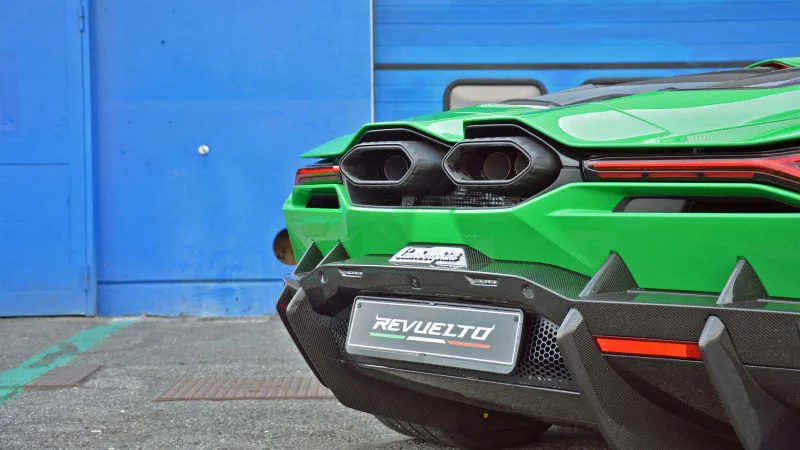
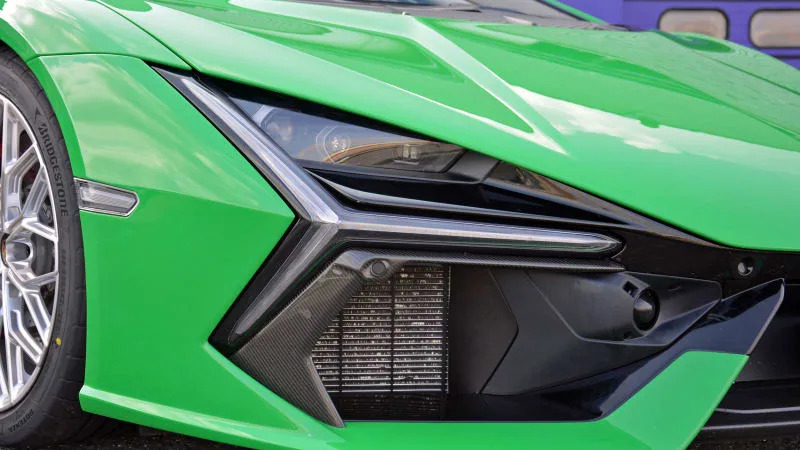
From a technical perspective, however, the Revuelto is pegged lightyears away from the supercars you had posters of on your bedroom wall if you grew up in the 1990s. Even the Aventador, which entered production in 2011, is comparatively simple: Remove the body and you’ll find a big, naturally-aspirated V12 engine, a transmission located in the tunnel named after it, and a great deal of carbon fiber bits.
Going hybrid forced Lamborghini to make several significant changes. Power comes from a new, dry-sump 6.5-liter V12 that remains naturally-aspirated, which is remarkable in an era when enthusiasts are being force-fed a stew of downsizing and forced induction. Using anything else was ruled out.
“Not for this car,” replied Rouven Mohr, the chief technical officer at Lamborghini, when I asked him if resorting to a smaller engine and/or a pair of turbochargers crossed his mind during the development process. “The V12 is our heritage icon. It would be a mistake from the pure emotional point of view to delete this. There are some examples in the market where our competitors [downsized and turbocharged] and they were not so happy afterwards,” he added without citing a specific brand or a specific model.

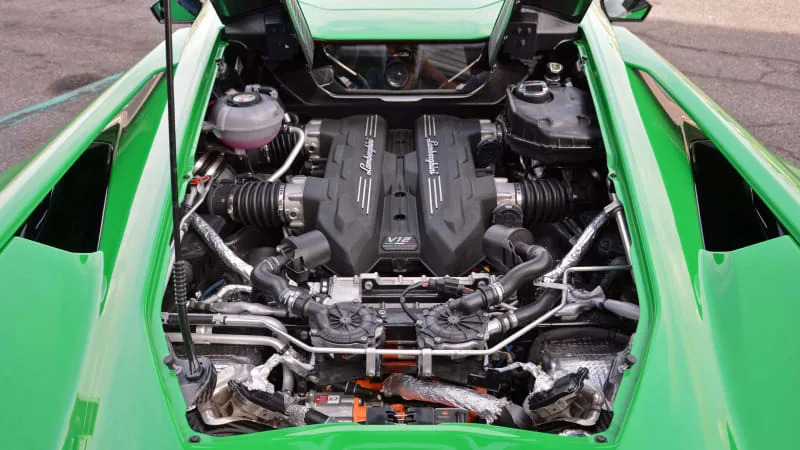
The engine remains mid-mounted, but engineers spun it by 180 degrees so that the output shaft (the part that sends power to the gearbox) faces the back end. The transmission is a new eight-speed dual-clutch unit mounted transversally, so the basic drivetrain forms a T. This part of the system spins the rear wheels only and isn’t connected to the front axle; the Revuelto offers through-the-road all-wheel-drive.
With the transmission hanging off the rear end, the transmission tunnel lost the tenant it had since the days of the Countach. The tunnel is still there, but it now houses a 3.8-kilowatt-hour lithium-ion battery pack that zaps three electric motors into motion. One is integrated into the transmission; the other two are assigned to each front wheel. This solution allowed Lamborghini to dial in torque vectoring while giving the Revuelto roughly six miles of electric-only range. That’s not much, but this isn’t a commuter, and the hybrid system isn’t there to neuter a supercar into a pseudo-EV; it’s for speed.
Lamborghini pegs the system’s total output at 1,001 horsepower — you know we’re talking serious power when there’s a comma in the number — and 793 pound-feet of torque. These figures make the 3,907-pound Revuelto the most powerful street-legal, series-produced car the brand has ever released. Hitting 62 mph from a stop takes about 2.5 seconds (that’s less time than it takes to read this sentence!) and top speed checks in somewhere north of 217 mph if you’ve got the tarmac and the guts for it.
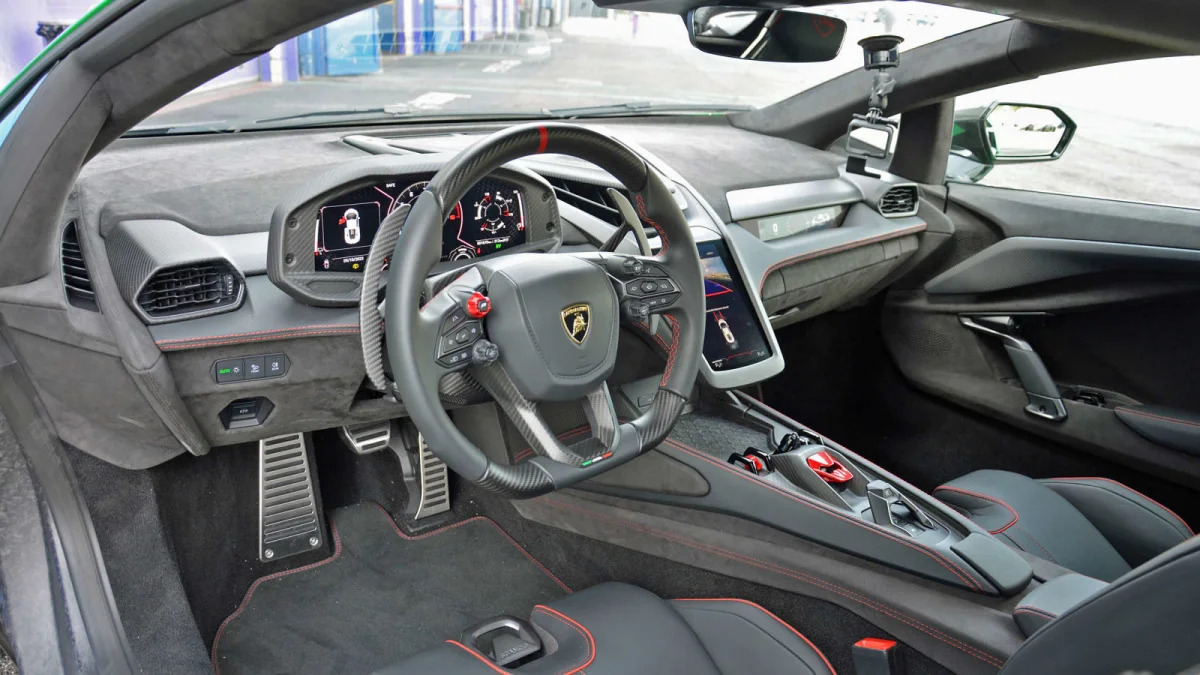
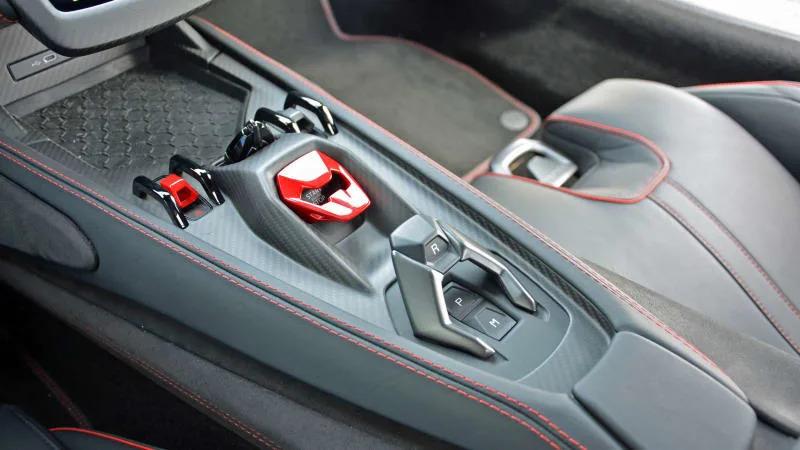

My time behind the wheel of the Revuelto was limited to about 15 laps of the Vallelunga track located near Rome, so I can’t comment on what it’s like to drive on spine-jarring cobblestones or in the countryside. As a side note, getting acquainted with a new Lamborghini on a race track is fitting, as the brand now takes racing seriously enough to enter a car in the 2024 FIA World Endurance Championship.
Paradoxically, the Revuelto doesn’t pretend it’s a race car. The upscale feeling you’d expect in a car that costs as much as a nice house in many ZIP codes is ensured by an abundance of carbon fiber, a blend of Alcantara and leather upholstery and contrast stitching. The start button remains under a little flap, so it is somewhat pretending to be a jet fighter.
The driver faces a three-spoke steering wheel jam-packed with buttons, huge carbon fiber shift paddles mounted on the steering column, and a 12.3-inch digital instrument cluster that can be configured to display a wide variety of information like media options, the driving mode selected, and navigation directions. The Y-shaped center console houses the same 8.4-inch, portrait-oriented touchscreen that’s fitted to the Huracán Evo, though the software (which Lamborghini points out it designed in-house) is Revuelto-specific, and there’s a 9.1-inch display in front of the passenger’s seat that provides the same information that’s shown in the instrument cluster.
It all looks lovely and suitably high-tech, but now is not the time to poke a screen.
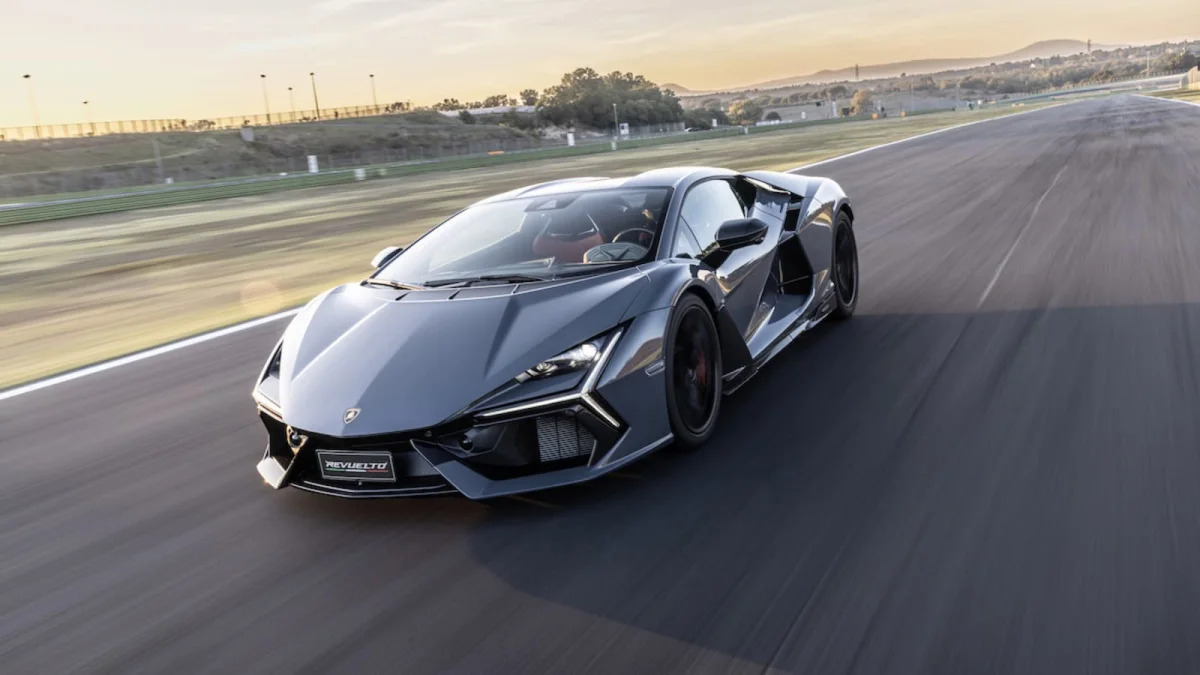
“Car number eight, it’s your turn” crackles out of the radio attached to the passenger-side seatbelt. With the driving mode set to “Corsa” and menacing clouds hovering above the track, I give the right-side shift paddle a firm pull to engage first gear and move my foot from the brake to the gas. You’re on a high-speed part of Vallelunga as soon as you exit the pits, but my first impression of the Revuelto isn’t related to its acceleration, exhaust note, or steering. It’s the shift from first to second that catches me off-guard.
In the Aventador, the Independent Shifting Rod (ISR) transmission delivered some of the harshest shifts I’ve ever experienced — it almost felt like the recoil you get when you fire a shotgun. I liked it. It’s quirks like this one that have historically contributed to the constitution of an Italian supercar’s character, but a lot of owners didn’t like it, and their opinion outweighs mine; my name doesn’t appear on Lamborghini’s list of clients. In contrast, the new dual-clutch gearbox delivers shifts that are equal parts smooth and crisp.
The speedometer indicates about 130 mph as I approach the track’s first corner — holy hell, already?
Although the Aventador never felt slow, the Revuelto is even quicker thanks in part to the instant torque delivered by the electric motors. They rocket this big coupe forward as the V12 revs towards its peak output, so they unlock better low-end acceleration in addition to putting more horses under your right foot. This is my kind of hybrid. I don’t know if they emit the distinct whine you hear in a lot of hybrid and electric models — probably, but the V12 shouting a foot away from your eardrums mutes their chatter.
It doesn’t sound like you’re driving a hybrid. It doesn’t feel like it, either. Some PHEVs deliver a rather incongruous driving experience. The engine does its own thing, the motors do their own thing, and at least one feels like a casting error. Not here. I’ll bet the cost of the optional carbon fiber sport seats that if you lap Vallelunga in the Revuelto without knowing what it’s powered by, you won’t say it’s a hybrid.
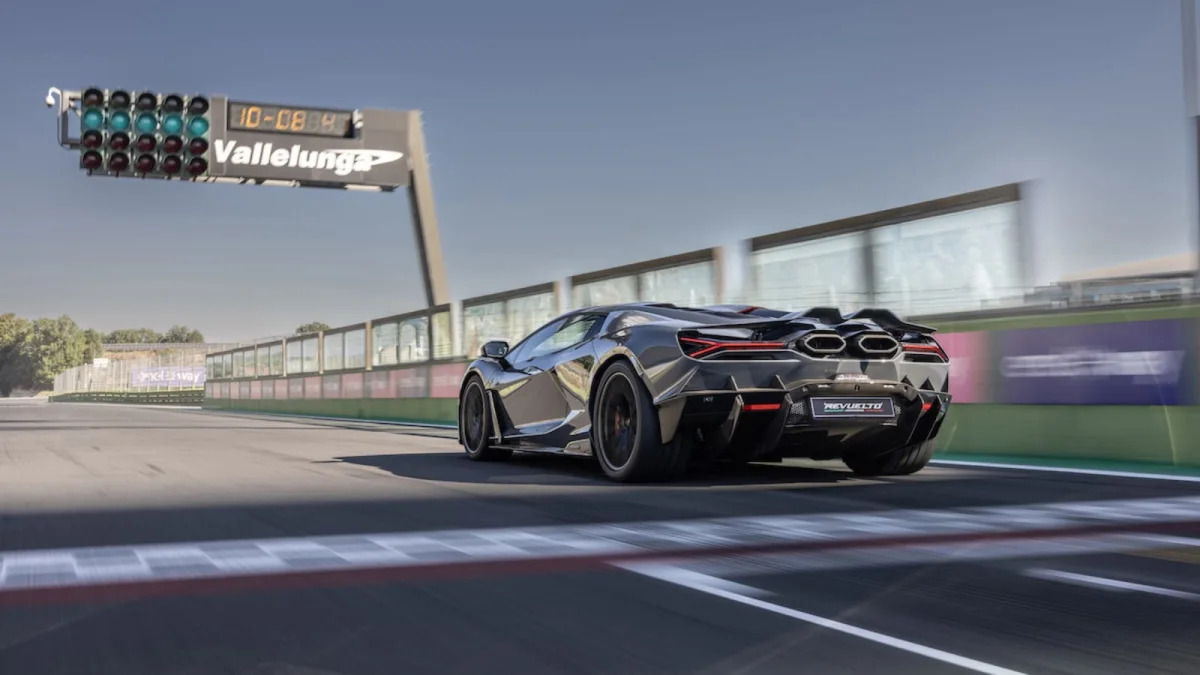
There’s a great deal of electronic wizardry brewing behind the scenes: Lamborghini fitted brake-by-wire technology and a brake energy recuperation system in addition to the usual bouquet of electronic driving aids. There’s torque vectoring on the front axle and rear-wheel steering. Both systems help make the Revuelto nimbler around a bend (they’re active whether it’s on a track or on a twisty road) but it’s the car’s brain that decides when and how much to use which one — imagine trying to do that yourself before every turn.
And yet, none of these features interfere with the driving experience; they’re digitally analog, as odd as this might sound. Even the brake pedal’s response is natural and predictable. You’re not driving a robot. You’re driving a car that looks, accelerates, brakes, and sounds like a Lamborghini flagship ought to.
The torque vectoring system doesn’t miss its cue to stop the Revuelto from taking all-you-can-eat turns at the understeer counter, resulting in handling you can accurately describe as “agile” — that’s no small feat for a car that’s as long as a BMW X5 and as wide as a Ford F-150. In a way, the hybrid system helps handling as well: The battery pack weighs approximately 165 pounds, and while the extensive use of carbon fiber helps offset that figure, it’s still there. It’s positioned right in the middle of the car, however, so it evens out the weight distribution by shifting the center of gravity forward.
Considering the improvements made in terms of performance, and taking into account the huge amount of technology that makes them possible, it’s a little surprising that Lamborghini managed to also make the Revuelto easier to live with on a daily basis. I didn’t drive it on a public road, as mentioned above, but my time on the track was enough to tell that it’s more spacious than the Aventador inside. There’s even room behind the seats for small items, like a briefcase or a purse. There’s more (front) trunk space, too.
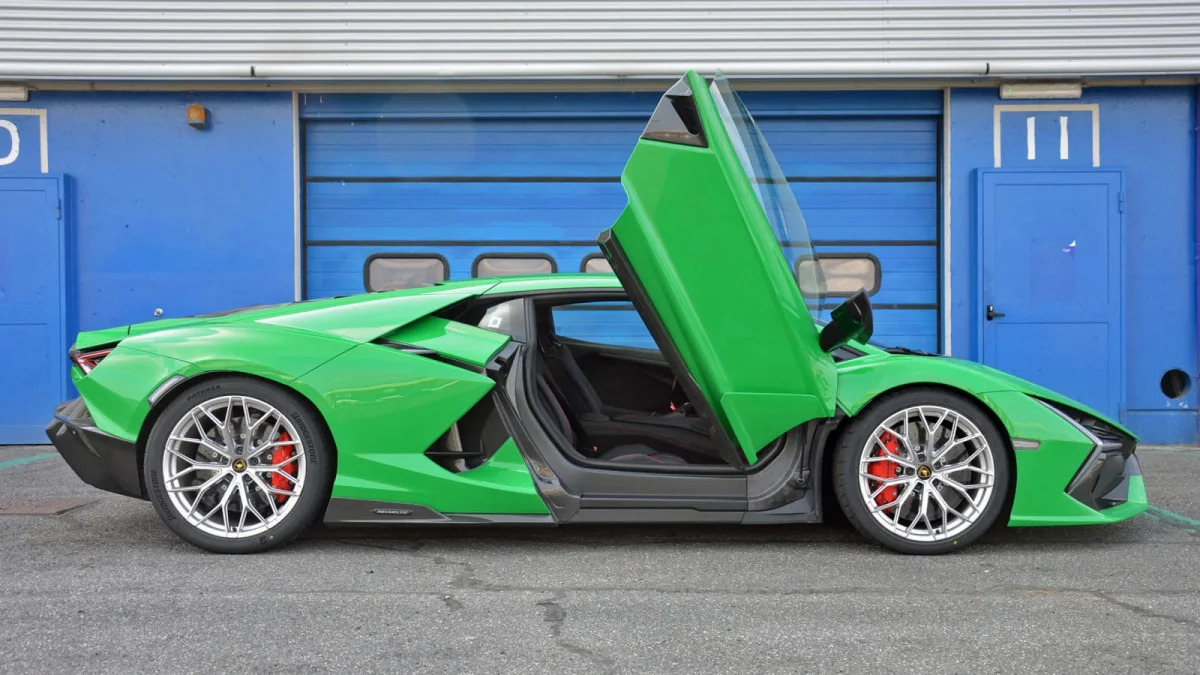
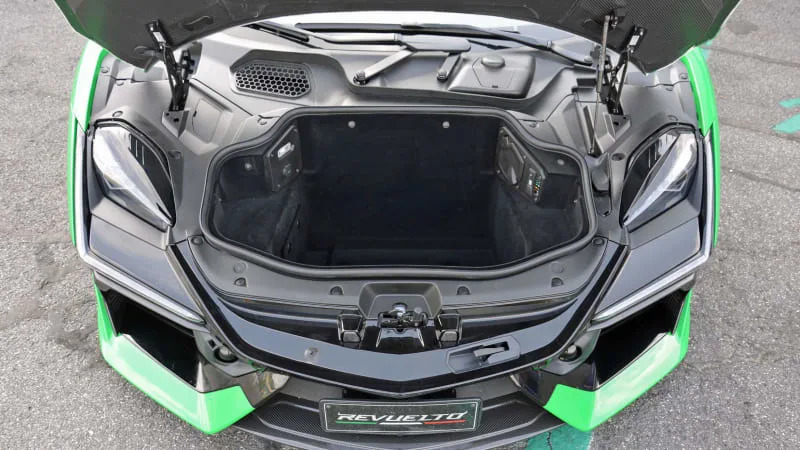

Speaking of the trunk, it’s where Lamborghini put the charging port. Inconvenient? Sort of, but it’s ultimately inconsequential.
“Based on our hybrid concept, it’s not needed,” Mohr explained. “The customer theoretically won’t often charge the car via the plug. You can, but the car recharges itself so fast that it’s not needed.”
It takes about six minutes of driving to top up the pack. He added that aesthetic and weight concerns, such as having to add an extra flap or having to run more wiring, played a role in this decision as well. So, while you need to keep the trunk open to charge the Revuelto, you don’t really need to charge it. If for some reason you want to while outside the safety of your garage, there’s a dual latch system that lets you keep the panel open just enough to slip a cable under it while still locking it.
It would have been frighteningly easy for Lamborghini to screw up. Nearly every part of the Revuelto is new, and the model is packed with technology that the brand has almost no experience with. It could have landed as a quick, loud Prius with two seats and scissor doors. It didn’t. It makes an excellent case for itself as the new representative of a lineage that includes the Miura, the Countach and the Diablo. The new V12 engine keeps tradition alive while making this flagship coupe an epoch-shaping supercar.
Built in Sant’Agata Bolognese, Italy, in the same factory that has made every Lamborghini since 1963, the Revuelto will reach America in 2024. That doesn’t mean you’ll be able to get one next year: It’s sold out for over two years, a stunning feat considering most orders were placed by folks who hadn’t driven it. They won’t be disappointed.
